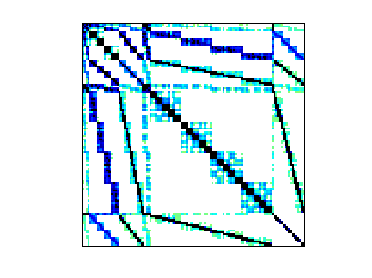Negre/dendrimer
Negre/dendrimer: phenyl dendrimer density matrix
| Name |
dendrimer |
| Group |
Negre |
| Matrix ID |
2850 |
|
Num Rows
|
730 |
|
Num Cols
|
730 |
|
Nonzeros
|
63,024 |
|
Pattern Entries
|
63,024 |
|
Kind
|
Computational Chemistry Problem |
|
Symmetric
|
Yes |
|
Date
|
2018 |
|
Author
|
C. Negre |
|
Editor
|
T. Davis |
| Structural Rank |
730 |
| Structural Rank Full |
true |
|
Num Dmperm Blocks
|
1 |
|
Strongly Connect Components
|
1 |
|
Num Explicit Zeros
|
0 |
|
Pattern Symmetry
|
100% |
|
Numeric Symmetry
|
100% |
|
Cholesky Candidate
|
yes |
|
Positive Definite
|
no |
|
Type
|
real |
| Download |
MATLAB
Rutherford Boeing
Matrix Market
|
| Notes |
Negre: phenyl dendrimer density matrix, for graph partitioning
The phenyl dendrimer structure is composed of 22 covalently bonded
phenyl groups. The density matrix hereby uploaded accounts for the
connectivity of 730 orbitals. This matrix has been used as a substrate
for implementing a graph-partitioning method using the D-wave quantum
annealer. See: https://dl.acm.org/citation.cfm?id=3149531
Christian F. A. Negre, Los Alamos National Lab, cnegre@lanl.gov
Graph Partitioning Using Quantum Annealing on the D-Wave System,
H. Ushijima-Mwesigwa, C. F. A. Negre, and S. M. Mniszewski,
Proc. of 2nd Intl. Workshop on Post Moore's Era Supercomputing,
(PMES17) 2017, Denver, CO, USA, 22--29, ACM.
Abstract:
Graph partitioning (GP) applications are ubiquitous throughout
mathematics, computer science, chemistry, physics, bio-science, machine
learning, and complex systems. Post Moore's era supercomputing has
provided us an opportunity to explore new approaches for traditional
graph algorithms on quantum computing architectures. In this work, we
explore graph partitioning using quantum annealing on the D-Wave 2X
machine. Motivated by a recently proposed graph-based electronic
structure theory applied to quantum molecular dynamics (QMD) simulations,
graph partitioning is used for reducing the calculation of the density
matrix into smaller subsystems rendering the calculation more
computationally efficient. Unconstrained graph partitioning as community
clustering based on the modularity metric can be naturally mapped into
the Hamiltonian of the quantum annealer. On the other hand, when
constraints are imposed for partitioning into equal parts and minimizing
the number of cut edges between parts, a quadratic unconstrained binary
optimization (QUBO) reformulation is required. This reformulation may
employ the graph complement to fit the problem in the Chimera graph of
the quantum annealer. Partitioning into 2 parts and k parts concurrently
for arbitrary k are demonstrated with benchmark graphs, random graphs,
and small material system density matrix based graphs. Results for graph
partitioning using quantum and hybrid classical-quantum approaches are
shown to be comparable to current "state of the art" methods and
sometimes better.
|
